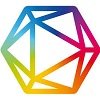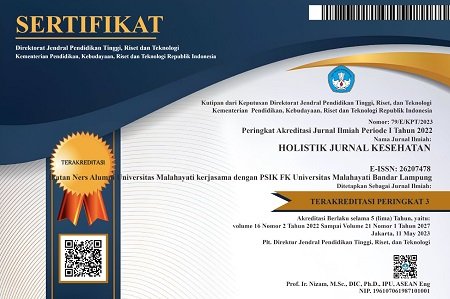LAMA RAWAT PADA PASIEN DENGAN CEDERA KEPALA RINGAN
Abstract
ABSTRACT : LENGTH OF STAY MILD HEAD INJURY IN SARI MUTIARA GENERAL HOSPITAL
Background : Early management of head injury patient in hospital will affect the outcome and length of stay mild head injury patient in the hospital.
Purpose : The purpose of this study were to identify the correlation among age, GCS and hyperglycemia with length of stay in the hospital.
Methods :The data obtained was analyzed by correlational analytic with retrospective approach. The sample of this study was recruited with consecutive sampling as 117 people. Data collected by observation from medical record on the mild head injury patients who come to hospital from March 2014 until March 2015 at Sari Mutiara General Hospital Medan. The data was analyzed by pearson and spearman correlation with significance α <0.05.
Results : The study showed that 70.1% Hyperglicemia, mean of age, GCS and length of stay were 32.09; 13,99 and 3.68 in mild head injury.There was no significantly correlation between age with length of stay (r = 0.163; p > 0.05). Whereas there was significant correlation between GCS and hyperglycemia with length of stay (r=-0.735; r = 0.610 ; p < 0.05)
Conclusion : Based on the study, we concluded that the more hyperglycemia, the more severe length of stay in patient with mild head injury.
Keywords: Mild head injury; GCS; Hyperglycemia; Length of stay
Pendahuluan: Penanganan awal pasien cedera kepala pada saat datang ke rumah sakit akan mempengaruhi outcome serta Length of Stay (LOS) pasien di rumah sakit
Tujuan : Penelitian ini bertujuan untuk mengetahui hubungan umur, GCS dan hiperglikemia dengan LOS pasien cedera kepala ringan di RSU Sari Mutiara Medan.
Metode : Metode penelitian dilakukan secara analitik korelasional dengan pendekatan retrospektif. Teknik sampling dalam penelitian ini menggunakan consecutive sampling dengan jumlah sampel sebanyak 117 orang yang diambil dari data sekunder yaitu observasi pada catatan medis pasien cedera kepala ringan yang dirawat di RSU Sari Mutiara Medan dalam periode satu tahun (Maret 2014 s.d Maret 2015). Data dianalisis menggunakan uji korelasi Pearson dan Spearman dengan signifikan α <0.05.
Hasil Penelitian: Hasil uji menunjukkan 70.1% pasien hiperglikemia, rata-rata umur pasien adalah 32.09 tahun, rata-rata GCS dan lama rawat pasien cedera kepala ringan adalah 13,99 dan 3.68 hari. Hasil uji menunjukkan tidak ada hubungan antara umur dengan LOS pasien cedera kepala ringan dengan nilai p=0,080 dengan kekuatan korelasi r = 0,163. Hasil uji didapatkan hubungan yang signifikan antara GCS dan hiperglikemia dengan LOS pasien cedera kepala ringan (p=0,000) dengan kekuatan korelasi (r=-0.735; r= 0,610).
Simpulan : Hal ini menunjukkan bahwa semakin tinggi hiperglikemia, maka semakin tinggi LOS pasien cedera kepala.
Keywords
Full Text:
PDFReferences
Aritonang, S. (2007). Hubungan Kadar Gula Darah dengan Outcome cedera Kepala Tertutup Derajat Sedang-Berat dengan Gambaran Brain CT Scan Normal. Semarang: Universitas Diponegoro.
Bethel. (2012). Emergency Care of Children and Adults With Head Injury. Nursing Standard. (43), 49-56.
Becker D., P., Miller J., D., Ward JD ., & et al. (2007). The outcome from severe head injury with early diagnosis and intensive management . J Neurosurg
Cochran, A., Scaife, E. R., Hansen, K. W., & Downey, E. (2003). Hyperglycemia And Outcomes From Pediatric Traumatic Brain Injury.
Gardner, S., Chany, F., & McKenzie. (2007). Factors associated with hospital length of stay and hospital charges of motor vehicle crash related hospitalizations among children in the United States. Arch Pediatr Adolesc Med 2007, 161(9), 889–895.
Godoy, D.A., Napoli, M.D., Biestro, A., & Leinhard, R. (2011). Perioperative Glukosa Control in Neurosergical Patient. Anesthesiologi Research ard Practice
Hanura, A. (2017). Jurnal Dinamika Kesehatan Status Fisiologis Pasien Cedera Kepala di IGD RSUD Ulin Banjarmasin, 8(1).
Hukkelhoven, C.W., Steyerberg., E.W., Rampean., A.J., & Farace, E. (2003). Patient age and outcome following severe traumatic brain injury: an analysis of 5600 patients.
Jiang, J. (2012). Head trauma in China. Injury, Int. J.Care Injured 44 (2013) , 1453– 1457.
Narayan.(2007). Prognosis After Head Injury. In: Neurological surgery.
Nurfaise. (2012). Hubungan Derajat Cedera Kepala Dan Gambaran Ct Scan Pada Penderita Cedera Kepala Di RSU Dr. Soedarso
Osler, T., Cook, A., Glance, L. G., Lecky, F., Bouamra, O., & Garrett, M., (2016). "The Differential Mortality of Glasgow Coma Score in Patients With and Without Head Injury." Injury, International Journal Care Injured 30:7.
Riset Kesehatan Dasar. (2013). Riset Kesehatan Dasar. Jakarta : Kementerian Kesehatan Republik Indonesia.
Rodriguez, M. (2013). Lessons from the field predicting mortality from head injury : experience of sancti spíritus province, Cuba lessons from the field. MEDICC. 15(3):30–3.
Sastrodiningrat, A. G. (2006). Memahami Faktor-Faktor yang Mempengaruhi Prognosa Cedera Kepala Berat. Suplemen Majalah Kedokteran Nusantara Volume 39 No. 3 September 2006.
Safrizal, Saanin, S., & Bachtiar. (2013). Hubungan nilai oxygen delivery dengan outcome rawatan pasien cedera kepala sedang. Padang: Universitas Andalas.
Sipayung. (2014). Analisis Faktor-Faktor Prediktor Yang Berhubungan Dengan Length Of Stay Pasien Cidera Kepala Ringan Di Rsu Pirngadi Medan. Tesis. Malang : Fakultas Kedokteran Universitas Brawijaya. Tidak Dipublikasikan.
Sipayung, N. P., & Syapitri, H. (2015). GCS sebagai prediktor length of stay pasien CKR di RSU Pringadi Medan. Medan. INJEC Vol 2 No 2 Okt 2015.indd.
Stead, LG., Bodhit, AN., Patel, PS .,& Daneshvar, Y. (2013). TBI surveilance using the common data elements for traumatic brain injury: a population study. International Journal of Emergency Medicine 2013. (5):1-7.
Waspadji, S. (2007).Penatalaksanaan DiabetesMelitus Terpadu. Jakarta: Fakultas Kedokteran Universitas Indonesia
Wiryana, M. (2008). Peranan Terapi Insulin Intensif Terhadap Interleukin Dan Luaran Klinik Pada Penderita Kritis Dengan hiperglikemia
DOI: https://doi.org/10.33024/hjk.v13i2.1391
Refbacks
- There are currently no refbacks.
Copyright (c) 2018

This work is licensed under a Creative Commons Attribution-NonCommercial 4.0 International License.














